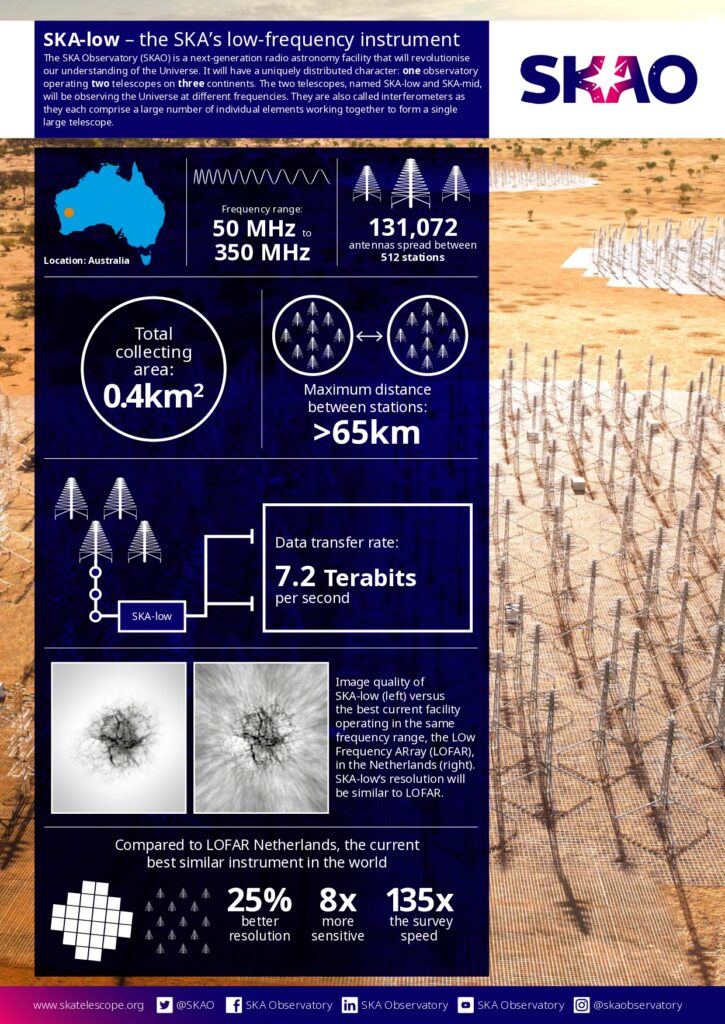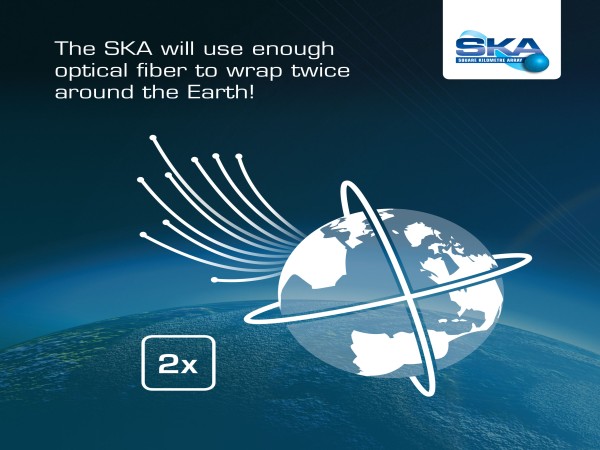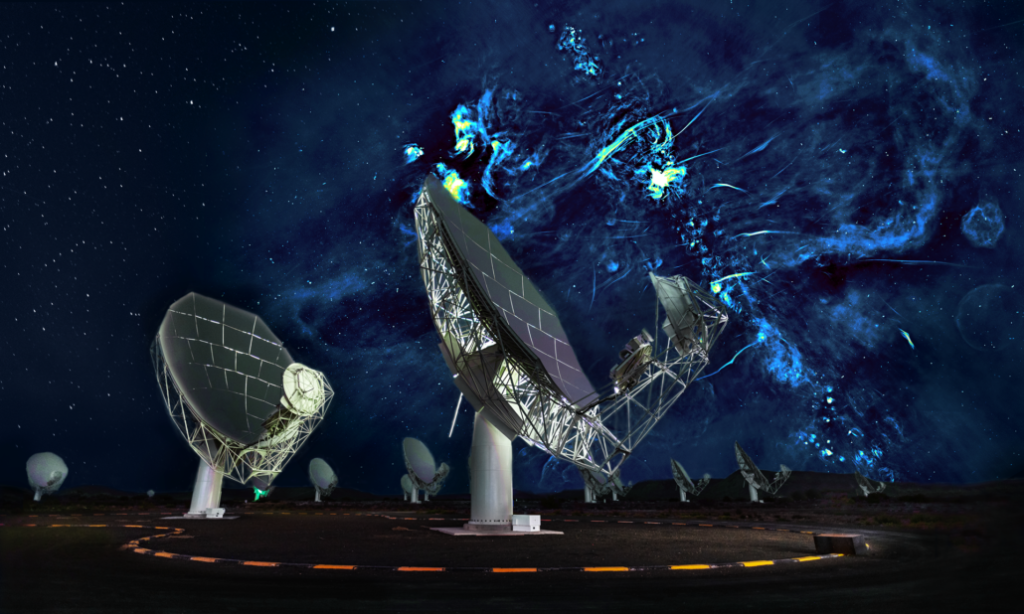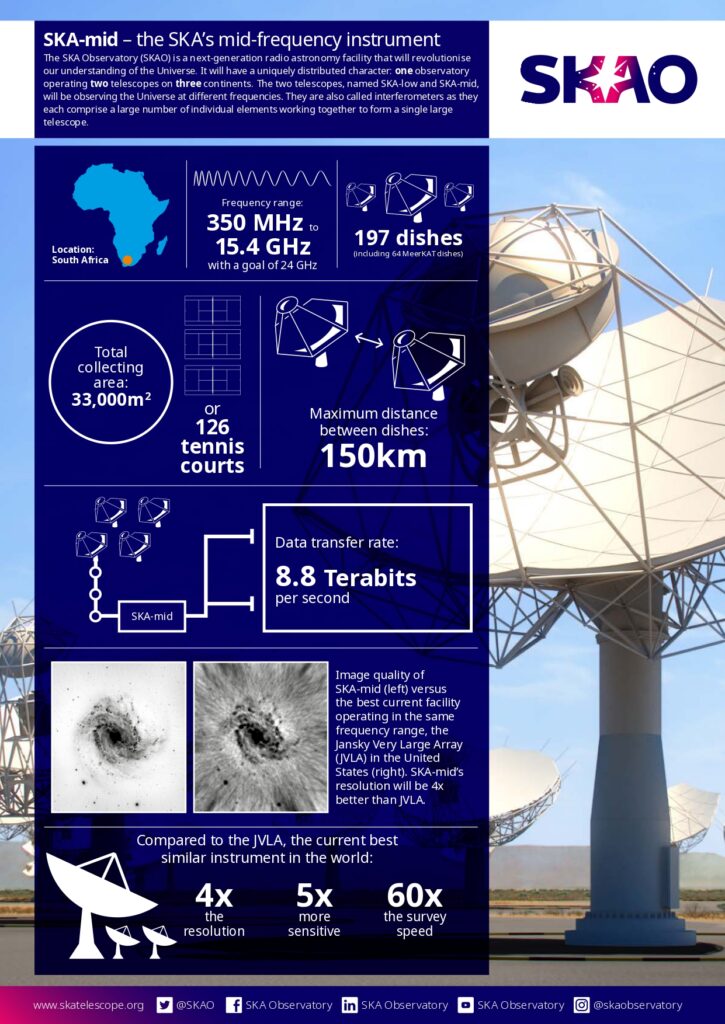telescope, radio astronomy, astronomy, radio, SKA, SKA observatory, square kilometre array, science, physics, telescopes, engineering, scientists, MeerKAT, Australia, South Africa, refractor telescope, reflector telescope, refracting telescope, reflecting telescope, radio telescope

Will the next decade be like a golden age for radio astronomy?
After 30 years of waiting, the biggest-ever adventure and expedition in the field of radio astronomy in the history of mankind started in Western Australia. The design of which took seven years to prepare. The construction of the entire project is expected to be completed in 2028. The project and the radio telescope are known as the ‘Square Kilometer Array’. The network will be constructed in Africa and Australia, but the exciting thing is that it will be headquartered in Britain.
The main objective of building a network of telescopes is to detect intelligent aliens or advanced life anywhere in the universe. Apart from this, the effect of Albert Einstein’s general theory of relativity is to be tested. How did the shape of the universe change over time? In scientific terms, how did the universe evolve? Scientists will also be able to gather information about it with the Square Kilometre Array (SKA) Telescope.
Construction commencement ceremonies were held in the Karoo region in the Northern Cape of South Africa and Murchison Shire in Western Australia.
This is the second major project by scientists since America launched an infrared observatory called the James Webb Space Telescope (JWST) a year or so ago. Experts put the cost, including construction and the first 10 years of operation, at around 1.9 billion Euros in 2020. Why is such a large telescope needed? What can radio telescopes contribute to science? Let’s gather scientific radio waves into your dish antenna.
Construction of the world’s largest radio telescope has begun!
Where is the SKA Observatory being built?
The construction of the world’s largest telescope network called the ‘Square Kilometre Array’ (SKA) has already begun at the cost of three billion dollars. For constructing the radio telescope, infrastructure facilities for data processing and fibre networks, Australia has signed various commercial contracts worth approximately 320 million dollars.
About 800 km north of Perth city, lies an area called Wajarri Yamaji Country, where the Murchison Radio Astronomy Observatory operates. Around this area, 131,072 antennas will be constructed and deployed at Inyarrimanha Ilgari Bundara (meaning “sharing sky & stars” in the Wajarri language).
In the first three decades of this project, a commercial investment of 1.8 billion dollars would have already taken place. About 350 jobs will also be created for science experts.
The greatest adventure in radio astronomy!
This project has member countries from all over the world. These include Britain, Australia, South Africa, Canada, China, France, Germany, India, Italy, New Zealand, Spain, Sweden, Switzerland and the Netherlands. In a large scientific project, how to analyze large amounts of computer data? How to process it? Its new experience will be available to scientists and computer engineers.
When the construction of the radio telescope network in South Africa and Australia is complete, scientists will be able to get an unparalleled view of the universe through the telescope. This will be the largest science facility on Earth to understand the universe.
Why build the SKA Telescopes in the Southern Hemisphere?
Sites in the Southern Hemisphere were chosen to be the locations of the SKA Observatory because they have a clear view of the entirety of the Milky Way, as well as views out into intergalactic space. In contrast, from more northerly countries such as the U.K., the core of our galaxy barely scrapes above the horizon during the summer months. However, the U.K. is not without its contribution to the SKA Observatory as its headquarters is at the Jodrell Bank Observatory in Cheshire, England.
How will the SKA Telescope work?
The ‘Square Kilometre Array (SKA)’ is a joint project between Australia and South Africa. Two types of radio telescopes will operate in the ‘Square Kilometer Array’; a giant special type of dish will be set up for mid-radio frequency whereas an antenna will be arranged for the low frequency.
The “Square Kilometer Array” will be the most sensitive radio telescope of any existing radio telescope on Earth.
For the SKA-LOW telescope, approximately 130,000 low-frequency antennas will be deployed in several areas of Western Australia. For radio telescopes, it is essential to see that the various radio frequencies coming from the surrounding areas do not interfere. The radio network shall be constructed in such a way that ‘other radio frequencies do not interfere with the dish and antenna of the project.

Each antenna will be two meters long and shaped like a Christmas tree. Due to the large antenna and many antenna arrays, the sensitivity of radio telescopes will increase. Its resolution will increase. More speed can be gained in surveying the sky.
It will then be observed using the interferometry technique, combining the waves. By converting signals similarly collected by radio antennas, astronomers can study the universe.

Thousands of miles of optical fibre link the individual dishes and antennas, and sophisticated software can take the data that each telescope collects and combine it precisely, using perfect synchronization for the different times it takes for the signals from the various dishes and antennas to reach the central processing system. The result is that each array acts as one giant telescope rather than a myriad of smaller telescopes.
When the telescope network of Africa and Australia becomes operational, the two sites together will collect 710 petabytes of science data. A new network technology will be created that will provide data flow at a rate 100,000 times faster than the estimated global average broadband speed. Processing the data collected by the massive radio telescope will require supercomputers capable of 8 to 10 terabytes of data processing power per second.
Last May, Britain announced the construction of the main brain-like computer required for the project, at the Square kilometre Array (SKA) headquarters in Manchester. Also, they are preparing special kinds of software for data processing. This software will tell the telescope network where and when to look. How to diagnose any problem? How to translate telescope signals into useful data? How to distinguish discoveries from translated data?
When will the SKA Observatory become operational?
Head of Telescope Operations in Australia, Dr Sarah Pearce said that “the SKA telescope would be sensitive enough to detect the radar of an airport on a planet orbiting a star ten light years away. In short, the questions in our minds can be answered by SKA! Are we alone in the universe? Or is there an extraterrestrial civilization far more technologically advanced than ours?”
Next year, will the dish and antenna of the radio network have the ability to work together or not? Scientists expect to test a handful of dishes and antennas to confirm this.
By the end of this decade (2028-29), the entire telescope network will be operational. The SKA will remain operational for the next fifty years. Simply put, the new radio telescope network will be able to scan the visible space beyond Earth 135 times faster than any existing radio telescope.
MeerKAT network of South Africa
The MeerKAT (meer – more & KAT – Karoo Array Telescope) facility for radio astronomy was launched in South Africa in July 2018, then known as the independent MeerKAT. The MeerKAT facility has been set up in the remote hinterland of Kenya and Ghana. Around which lies the vast protected land area of Carnavon which is restricted for the movement of people. As it is surrounded by high hills, radio waves beamed down to Earth are impeded.
The currently operational MeerKAT facility will be connected to the first phase of the ‘Square Kilometer Array’ construction. In the future, about 200 mid-frequency dishes will be deployed in the MeerKAT facility in the Karoo region of South Africa. South Africa said that its existing 64 radio telescope dishes of MeerKAT would be combined with new 133 dishes to form a large network to form SKA-Mid in the first phase of developing the ‘Square Kilometer Array’. MeerKAT will be converted to SKA-Mid in the future.

(Image credit: American Astronomical Society)
MeerKAT recently provided scientists with images of several phenomena, including the chaotic region surrounding the supermassive black hole at the centre of our galaxy. It also provided radio images of stellar nurseries where stars are born.
Radio Astronomy: The Golden Age will begin!

Land agreements have been made with the Wajarri people and farmers in the Karoo in Western Australia to start the SKA observatory. The ‘Square Kilometre Array’ network will initially have 197 dishes and 131,072 antennas deployed in South Africa and Australia. More than 500 engineers and more than a thousand scientists from more than 20 countries are involved in the construction of the project.
Made with modern technology, low-frequency radio telescopes can see the sky more clearly. A low-frequency radio telescope will pick up low-frequency waves with a wavelength of about 1 meter, coming from billions of light years away. A very faint object in the universe will be able to be identified in greater detail.

The period between the beginning of the universe and the first ray of light in the universe is known by scientists as the Dark Age. What happened during this period? How were the first stars and galaxies formed? It can be best studied with a low-frequency radio telescope. What was the role of hydrogen atoms in the creation of the first light ray? It may become clear. Gravitational waves released by dead stars can be detected with the telescope.
Also, there is a burst of mysterious radio waves in the universe which scientists call a “fast radio burst”. The burst duration of such radio waves is in milliseconds. The ‘Square Kilometre Array’ will help to solve the mystery of this ‘fast radio burst’. The SKA observatory will chart the birth and death of galaxies, discovering new types of gravitational waves.
It will expand the boundaries of what we know about the universe. In short, the next fifty years will be a golden age.
Additional Resources
Learn how radio interferometers work with these resources from the National Radio Astronomy. Explore radio astronomy in more detail with astronomers at the Australia Telescope National Facility.
Read more: Scientists found a rare 7.6kg meteorite in Antarctica
Read more: Scientists steer lightning bolts with lasers for the first time

2 thoughts on “Square Kilometer Array Radio Telescope”